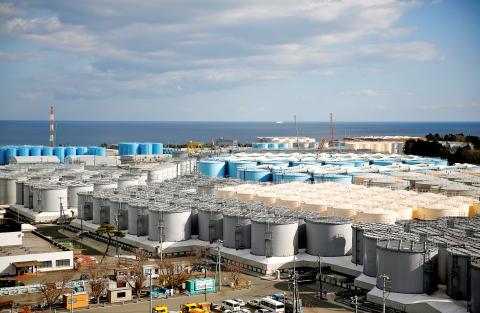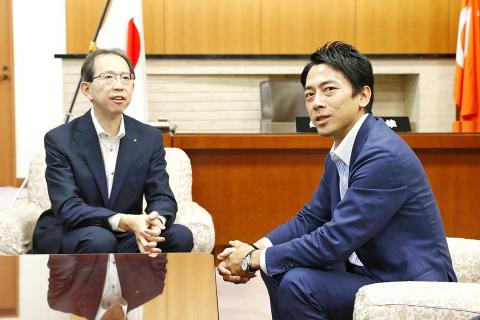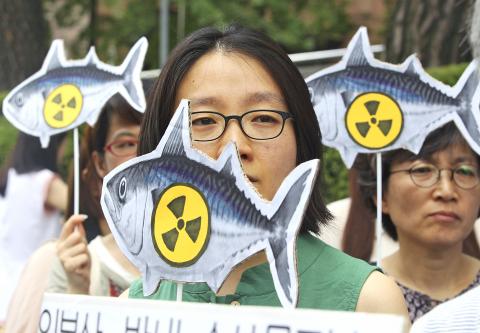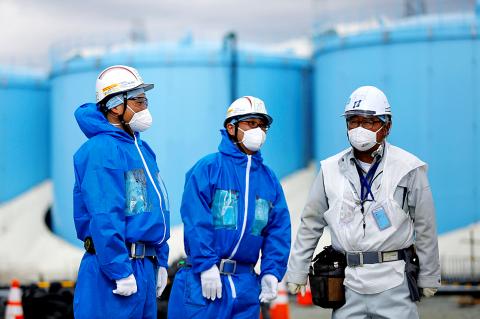Japan’s environment minister Shinjiro Koizumi has called for the country’s nuclear reactors to be scrapped to prevent a repeat of the Fukushima nuclear disaster.
Koizumi’s comments, made on Sept. 11, hours after he became Japan’s third-youngest cabinet minister since the war, could set him on a collision course with Japan’s pro-nuclear prime minister, Shinzo Abe.
“I would like to study how we will scrap them, not how to retain them,” Koizumi, 38, said. “We will be doomed if we allow another nuclear accident to occur. We never know when we’ll have an earthquake.”

Photo: Reuters
照片:路透
Koizumi faced an immediate challenge from the new trade and industry minister, Isshu Sugawara, who said that ridding Japan of nuclear power was “unrealistic.”
“There are risks and fears about nuclear power,” Sugawara told reporters. “But ‘zero-nukes’ is, at the moment and in the future, not realistic.”
Japan’s government wants nuclear power to comprise 20 percent to 22 percent of the overall energy mix by 2030, drawing criticism from campaigners who say nuclear plants will always pose a danger given the country’s vulnerability to large earthquakes and tsunamis.

Photo: AP
照片:美聯社
Abe, however, has called for reactors to be restarted, arguing that nuclear energy will help Japan achieve its carbon dioxide emissions targets and reduce its dependence on imported gas and oil.
All of Japan’s 54 reactors were shut down after a giant tsunami caused a triple meltdown at the Fukushima Daiichi nuclear power plant in March 2011.
Nuclear power accounted for about 30 percent of Japan’s energy production before the disaster. Today, just nine reactors are back in operation, having passed stringent safety checks introduced after the Fukushima meltdown.

Photo: AP
照片:美聯社
But the government is unlikely to meet its target of 30 reactor restarts by 2030 amid strong local opposition and legal challenges.
Although he faces potential opposition from inside the cabinet, Koizumi should at least receive the backing of his father, Junichiro Koizumi, a former prime minister who has emerged as a vocal opponent of nuclear power.
While Japan debates the future of nuclear energy, the younger Koizumi, who has been tipped as a future prime minister, is now at the center of a controversy over the future of more than a million metric tonnes of radioactive contaminated water stored at Fukushima Daiichi.

Photo: Reuters
照片:路透
On September10, the previous environment minister, Yoshiaki Harada, said the plant’s operator, Tokyo Electric Power, had no choice but to dilute the water and release it into the Pacific Ocean rather than store it indefinitely.
The prospect of dumping the water into the sea has angered local fishermen and drawn protests from neighboring South Korea.
(The Guardian)
日本新任環境大臣小泉進次郎呼籲日本將核反應爐報廢,以防止福島核災重演。
小泉進次郎為日本戰後第三年輕的內閣大臣,九月十一日甫上任數小時後即做出如上表示,小泉此番言論可能使他與擁核的首相安倍晉三發生衝突。
「我想研究如何停用核反應爐,而不是如何保留它」,三十八歲的小泉說。「如果我們讓核事故再度發生,我們就註定會滅亡。我們永遠不知道什麼時候會發生地震。」
小泉面臨新任經濟產業大臣菅原一秀的直接挑戰──菅原說,若要日本擺脫核電,是「不切實際的」。
「核電有其風險和可怕之處」,菅原一秀告訴記者。「但是『零核電』在現今和未來都是不切實際的」。
日本政府計畫,到二○三○年,核電將佔整體能源結構的百分之二十至二十二。這受到活動人士的批評,說日本易發生大地震和海嘯,核電廠永遠會構成危險。
然而,安倍呼籲重新啟動反應爐,認為核能將有助日本達成二氧化碳排放目標,並減少對進口天然氣和石油的依賴。
二○一一年三月的一場大海嘯,造成福島第一核電廠一至三號機的反應爐心皆熔毀,日本隨即將國內五十四座反應爐全部關閉。
福島核災發生之前,核電約佔日本能源產量的百分之三十。現今只有九座反應爐通過福島核災後制定的嚴格安全檢查而重啟。
但由於當地強烈的反對和法律的挑戰,日本政府不太可能在二○三○年前實現重啟三十個反應爐的目標。
雖然小泉進次郎可能會面臨來自內閣的反對,但他起碼會得到其父小泉純一郎的支持;小泉純一郎曾任日本首相,現已是大力反對核電的要角。
日本正爭辯核能該何去何從,但對於福島第一核電廠所儲存的一百多萬噸受輻射污染的水該何去何從,此刻卻讓未來首相熱門人選小泉進次郎身處爭議的中心。
九月十日,時任環境大臣的原田義昭表示,福島核電廠的營運商東京電力公司別無選擇,只能把這些輻射汙染水稀釋、倒進太平洋,而不是無限期貯存起來。
這些輻射水可能會倒入海中的消息激怒了當地漁民,並引起了鄰國南韓的抗議。
(台北時報林俐凱編譯)
FOLLOW UP
讀後練習
Questions
1. What is the Japanese government’s stance on nuclear energy? Do the prime minister and environment minister agree with each other on this matter?
2. Why is the Japanese environment minister considering scrapping nuclear power?
3. What are pro-nuclear politicians basing their arguments on?
4. What is the Japanese government’s plan for dealing with the radioactive contaminated water stored at Fukushima?
(Lin Lee-kai, Taipei Times)

For many people in Taiwan, childhood memories of rural life include pig pens standing beside family homes. Leftover rice, vegetable scraps and soup from daily meals were poured into buckets and fed to pigs. This practice of feeding pigs with household food waste was once a common way of life, both an economic choice and an expression of agricultural society’s deep respect for conserving resources. From a practical standpoint, pigs are omnivorous animals capable of efficiently digesting food scraps that humans can no longer eat. For rural households, food waste cost almost nothing, yet it could be converted into pork, a

Tango unfolds in a dimly lit room, where a haunting melody ushers two dancers into a close embrace. Here, music and movement merge into a silent yet passionate conversation, expressing longing, memory and shared purpose. What makes tango truly magical is the deep interaction and spontaneous improvisation between partners. Tango began in the late 19th century in Buenos Aires, Argentina’s bustling capital. Born in the poor working-class neighborhoods and busy port areas, this dance emerged from a melting pot of cultures. European immigrants, African slaves and local residents all contributed to its unique character. From these rich influences, tango

A: Apart from the Taipei Music Center’s exhibit and concert, US pop rock band OneRepublic and rapper Doja Cat are touring Kaohsiung this weekend. B: OneRepublic is so popular that after tonight’s show at the K-Arena, they are set to return to Taiwan again in March next year. A: And Doja will also perform at the same venue on Sunday, right? B: Yup. Her collab with Blackpink’s Lisa and singer Raye for the song “Born Again” has been a huge worldwide success. A: Doja even made it on Time magazine’s “100 Most Influential People” list in 2023. She’s so cool. A: 本週末除了北流的特展和演唱會外,美國男團共和世代和饒舌歌手蜜桃貓朵佳也將來台開唱。 B: 共和世代因太受歡迎,繼今晚高雄巨蛋的演唱會後,預計明年3月即將再度來台巡演唷。 A: 朵佳本週日將在同場地開唱,對不對?

A: What show are you watching online? B: I’m watching “Fly Me to the Moon & Back” – an exhibition launched by the Taipei Music Center (TMC) to commemorate the late singer Tom Chang. A: Known for his sky-high notes, Chang is praised as one of the best singers in the 1990s. His death at the age of 31 was a major loss indeed. B: And I’m so glad that we went to the TMC’s 90s-themed concert last Friday. I finally saw the iconic “Godmother of Rock” WaWa perform live. A: This year-end show also featured singers Princess Ai, Bii, Wayne Huang, PoLin and